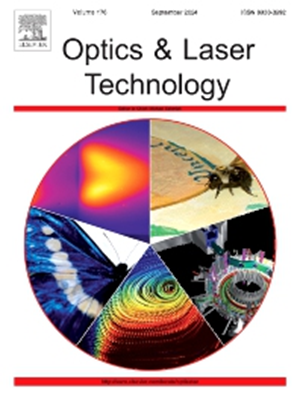In-situ monitoring and metallographic observations of mass transfer and defect formation during AlSi10Mg additive manufacturing using powder sheets
IF 4.6
2区 物理与天体物理
Q1 OPTICS
引用次数: 0
Abstract
Metal additive manufacturing using powder sheets (MAPS) melts powder attached in a sheet with a polymer binder, avoiding risks of loose powders in material waste, safety and health during laser additive manufacturing among other for e-mobility applications. However, this concept remains challenging for aluminum alloys due to occurring defects. To address this challenge, the mass transfer and defect formation mechanism during MAPS-AlSi10Mg were investigated using high-speed imaging and metallographic observations. The results showed that the mass transfer is realized via droplets formed first from the powder sheet in front of the melt pool and their incorporations into the melt pool. However, a much laser defocusing significantly inhibits the droplets’ incorporation into the melt pool and promotes the balling. Polymer coatings or it wrapped into the AlSi10Mg droplets, generates the inclusions once the droplets were incorporated into the melt pool. Furthermore, under the laser beam in focus, the large particle-size powder sheet, powder side up or low scanning speed easily induce pores via shielding gas/polymer vapor inclusion. The laser defocusing of +15 mm, average laser intensity of W/cm2, and binder side up induce defect-free tracks, owing to the complete removal of polymers by their sufficient evaporation and powder agglomeration spatters. This work unveils that the droplets’ incorporation into melt pool leads to the mass transfer of MAPS-AlSi10Mg while the droplets containing polymers and gas/vapor inclusion generate inclusions and pores. Meanwhile, the defect-free production strategy of suitable defocusing and high laser intensity is proposed.
AlSi10Mg粉末板材增材制造过程中传质和缺陷形成的现场监测和金相观察
使用粉末片(MAPS)的金属增材制造使用聚合物粘合剂将附着在薄片上的粉末熔化,避免了材料浪费中粉末疏松的风险,以及激光增材制造过程中的安全和健康风险。然而,由于铝合金存在缺陷,这一概念仍然具有挑战性。为了解决这一挑战,利用高速成像和金相观察研究了map - alsi10mg过程中的传质和缺陷形成机制。结果表明,在熔池前的粉末片上首先形成液滴,并将液滴带入熔池中,从而实现传质。然而,大量的激光散焦显著地抑制了液滴进入熔池并促进了球化。聚合物涂层或包裹在AlSi10Mg液滴中,一旦液滴进入熔池,就会产生夹杂物。此外,在激光束聚焦下,大粒径粉末片、粉末面朝上或低扫描速度容易通过屏蔽气体/聚合物蒸气包裹体诱发孔隙。激光离焦为+15 mm,平均激光强度为1.6×105 W/cm2,粘结剂侧朝上,通过充分的蒸发和粉末团聚飞溅完全去除聚合物,从而产生无缺陷的轨迹。研究表明,液滴加入熔池导致map - alsi10mg的传质,而含有聚合物和气体/蒸汽包裹体的液滴产生包裹体和孔隙。同时,提出了适当散焦和高激光强度的无缺陷生产策略。
本文章由计算机程序翻译,如有差异,请以英文原文为准。
求助全文
约1分钟内获得全文
求助全文
来源期刊
CiteScore
8.50
自引率
10.00%
发文量
1060
审稿时长
3.4 months
期刊介绍:
Optics & Laser Technology aims to provide a vehicle for the publication of a broad range of high quality research and review papers in those fields of scientific and engineering research appertaining to the development and application of the technology of optics and lasers. Papers describing original work in these areas are submitted to rigorous refereeing prior to acceptance for publication.
The scope of Optics & Laser Technology encompasses, but is not restricted to, the following areas:
•development in all types of lasers
•developments in optoelectronic devices and photonics
•developments in new photonics and optical concepts
•developments in conventional optics, optical instruments and components
•techniques of optical metrology, including interferometry and optical fibre sensors
•LIDAR and other non-contact optical measurement techniques, including optical methods in heat and fluid flow
•applications of lasers to materials processing, optical NDT display (including holography) and optical communication
•research and development in the field of laser safety including studies of hazards resulting from the applications of lasers (laser safety, hazards of laser fume)
•developments in optical computing and optical information processing
•developments in new optical materials
•developments in new optical characterization methods and techniques
•developments in quantum optics
•developments in light assisted micro and nanofabrication methods and techniques
•developments in nanophotonics and biophotonics
•developments in imaging processing and systems

 求助内容:
求助内容: 应助结果提醒方式:
应助结果提醒方式:


